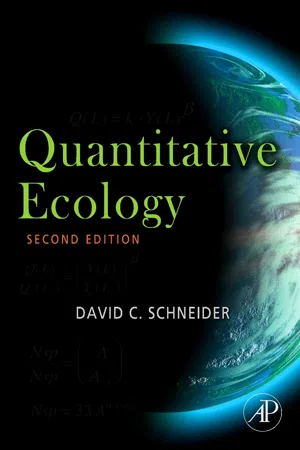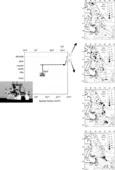1.1. The Need for Quantitative Reasoning
Important questions in ecology are more than a matter of biology; they affect our well-being and they have an ethical component. An example is species diversity on a tropical reef. This diversity poses one of the central questions in biology: Why are there so many species in such a small area, and what caused such diversity? This variety of species affects the well-being of island people who fish the waters of the reef. Their lives and culture are adjusted to the peculiarities of the species found on the reef. The well-being of island people who make a living from tourism depends on the continued diversity of the reef. At a larger scale, the well-being of still more people will be altered by therapeutics discovered among the many unique physiologies that coexist on a reef. The diversity of species on a coral reef also raises ethical issues. Reef inhabitants, tourists, and the beneficiaries of new therapeutics lose if diversity is eroded by destructive practices such as dynamiting for fish or discharging nutrients over a reef. The ethical issues created by fish dynamiters are clear-cut; the ethical issues raised by tourists are more complex via unintended consequences such as reef loss through increased discharge of nutrients in waste streams.
For the ecologists who study ecosystems, pressing questions have an additional characteristic—that of the complexity of multiple causation. Among the processes responsible for coral reef diversity are regional history, frequency of disturbance, and differential predation on common species. These processes often interact. For example, a sessile species may overgrow its neighbor at low rates of nutrient supply, but not at high rates. The interacting effects of nutrient supply and competitive capacity maintain diversity by repeatedly reversing the outcome of competition for space. Multiple causes act at different space and time scales. The number of species and their relative abundance on a patch reef will depend not only on the competitive interactions among neighboring organisms but also on the resupply of larval recruits from other patch reefs.
Pressing problems in ecology are often attended by substantial uncertainty. Some of this uncertainty will arise from measurement error. If we look at the role of fish predators on a reef by excluding them from sites that range from high to low prey density, the experimental outcome will vary in part because of error in measurement of initial and final prey density. The experimental outcome will also vary because of process error, the sum effect of all the unknown factors that change prey density. In a laboratory setting, process error can be reduced substantially by manipulative control. But in field experiments, process error will remain large in even the mostly tightly controlled experiment.
How do we address ecological problems characterized by complexity and uncertainty? We have no choice but to use a model to simplify and make sense of the situation. In biology, the classic solution to the problem of complexity is a verbal or graphical model obtained by the comparative method. A classic example of the success of the comparative method is Darwin’s theory of coral atolls. Comparisons of Pacific islands uncover similarities that establish an historical sequence, which begins with a volcanic island fringed by reefs. These continue to grow upward into the light as the island erodes, leaving a ring-shaped atoll. Another example is the phyletic assignment of fossils from the middle Cambrian in the Burgess shale formation in eastern British Columbia. Comparisons of fossil fragments uncover similarities that establish the presence of sponges, echinoderms, chordates, four major groups of arthropods, and species that defy placement in known phyla. Yet another example of a model due to the comparative method is a diagram of the vertebrate nervous system, with its dorsal nerve cord and dendritic structure. The diagram is a model extracted from comparative dissections of organisms as diverse as fish and kangaroos. In these examples generalization resulted from qualitative comparison of units, without quantitative treatment.
The comparative method has a long record of success in biology and geology, most notably where the impress of history is strong, as in morphology, embryology, palaeontology, and stratigraphy. At the much shorter time scales of human actions and pressing ecological problems, the method of comparing and contrasting a series of cases will sometimes serve, but more often measurement will serve better. This in turn will require quantitative models to simplify and extract meaning from the data.
The first step toward a quantitative model is verbal—a statement of the relation among measurable variables (Figure 1.1). An example is the statement that release of nutrients into a lagoon will alter coral abundance. A verbal model can address both causality and uncertainty: the effect of nutrients on coral in a lagoon may occur with considerable local variation. The verbal model is the door to a graphical model, in which data are simplified to a graphical model, as in Figure 1.1. For example, we could sketch the expected form of the relation of coral growth to nutrient release rate from previous data showing that high nutrient levels slow the growth of coral. Data can be simplified to a formal model. An equation describing growth in relation to nutrient levels in the lab could be used as a preliminary model to predict effects in the lagoon. The number of samples needed to detect the predicted effect could be computed from a model of uncertainty, such as normal error distribution.
At any level, whether verbal, graphical, or formal, a model is a simplification of the complex causality and inevitable uncertainty that attend pressing ecological problems. The simplification provided by a model is a necessary part of disentangling causality. A formal model can also address uncertainty. Such a model will have a structural component (the causal part) and an error component (the uncertainty part). Such models make best use of data in advancing understanding of the problem and in addressing uncertainty during decision making.
Another Look at Section 1.1
1. State an ecological question of interest to you, then briefly state its societal importance, intrinsic biological interest, and ethical implications.
2. State an ecological question of interest to you, then list relevant variables and sources of u...

